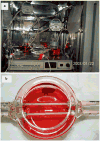Use of human mesenchymal stem cells as alternative source of smooth muscle cells in vessel engineering
- PMID: 21431526
- PMCID: PMC3151526
- DOI: 10.1007/978-1-60761-999-4_21
Use of human mesenchymal stem cells as alternative source of smooth muscle cells in vessel engineering
Abstract
Adult stem cell-derived smooth muscle cells (SMC) may be a promising source of cells for applications in regenerative medicine, including cardiovascular tissue engineering. Primary SMC from native vessels may have limited proliferative capacity and reduced collagen production when sourced from elderly donors, who are the patients in need of vascular grafts due to coronary disease or peripheral arterial disease. Our recent work showed that the ability of human bone marrow-derived mesenchymal stem cells (hMSCs) to differentiate into SMC was modulated by various growth factors, matrix proteins, and mechanical forces. In addition, the components of the culture medium play a very important role in SMC differentiation from hMSCs. In this chapter, we will summarize our experience with the impact of various factors on SMC differentiation from hMSCs. Based upon our findings regarding growth factors, cyclic strain and matrix proteins, a two-phase vessel regeneration culture protocol including a 4-week proliferation phase and a 4-week differentiation phase was developed to optimize proliferation and SMC differentiation of hMSCs consecutively.
Figures




Similar articles
-
Small-diameter human vessel wall engineered from bone marrow-derived mesenchymal stem cells (hMSCs).FASEB J. 2008 Jun;22(6):1635-48. doi: 10.1096/fj.07-087924. Epub 2008 Jan 16. FASEB J. 2008. PMID: 18199698 Free PMC article.
-
Influence of culture medium on smooth muscle cell differentiation from human bone marrow-derived mesenchymal stem cells.Tissue Eng Part A. 2009 Feb;15(2):319-30. doi: 10.1089/ten.tea.2008.0161. Tissue Eng Part A. 2009. PMID: 19115826 Free PMC article.
-
Effects of extracellular matrix on differentiation of human bone marrow-derived mesenchymal stem cells into smooth muscle cell lineage: utility for cardiovascular tissue engineering.Cells Tissues Organs. 2010;191(4):269-80. doi: 10.1159/000260061. Epub 2009 Nov 19. Cells Tissues Organs. 2010. PMID: 19940434
-
Biomimetic control of vascular smooth muscle cell morphology and phenotype for functional tissue-engineered small-diameter blood vessels.J Biomed Mater Res A. 2009 Mar 15;88(4):1104-21. doi: 10.1002/jbm.a.32318. J Biomed Mater Res A. 2009. PMID: 19097157 Review.
-
Regulation of vascular smooth muscle cells and mesenchymal stem cells by mechanical strain.Mol Cell Biomech. 2006 Mar;3(1):21-34. Mol Cell Biomech. 2006. PMID: 16711069 Review.
Cited by
-
The use of optical clearing and multiphoton microscopy for investigation of three-dimensional tissue-engineered constructs.Tissue Eng Part C Methods. 2014 Jul;20(7):570-7. doi: 10.1089/ten.TEC.2013.0538. Epub 2014 Jan 16. Tissue Eng Part C Methods. 2014. PMID: 24251630 Free PMC article.
-
Directional Topography Influences Adipose Mesenchymal Stromal Cell Plasticity: Prospects for Tissue Engineering and Fibrosis.Stem Cells Int. 2019 May 5;2019:5387850. doi: 10.1155/2019/5387850. eCollection 2019. Stem Cells Int. 2019. PMID: 31191675 Free PMC article.
-
The evolution of vascular tissue engineering and current state of the art.Cells Tissues Organs. 2012;195(1-2):144-58. doi: 10.1159/000331406. Epub 2011 Oct 13. Cells Tissues Organs. 2012. PMID: 21996786 Free PMC article. Review.
-
3D bioprinting of vascular conduits for pediatric congenital heart repairs.Transl Res. 2019 Sep;211:35-45. doi: 10.1016/j.trsl.2019.03.007. Epub 2019 Apr 11. Transl Res. 2019. PMID: 31034816 Free PMC article. Review.
-
Small-diameter vascular graft engineered using human embryonic stem cell-derived mesenchymal cells.Tissue Eng Part A. 2014 Feb;20(3-4):740-50. doi: 10.1089/ten.TEA.2012.0738. Tissue Eng Part A. 2014. PMID: 24125588 Free PMC article.
References
-
- Kadner A, Heorstrup SP, Zund G, Eid K, Maurus C, Melinitchouk S, Grunenfelder J, Turina MI. A new source for cardiovascular tissue engineering: Human bone marrow stromal cells. Eur J Cardiothorac Surg. 2002;21:1055–1060. - PubMed
-
- Hoerstrup SP, Kadner A, Melnitchouk S, Trojan A, Eid K, Tracy J, Sodian R, Visjager JF, Kolb SA, Grunenfelder J, Zund G, Turina MI. Tissue engineering of functional trileaflet heart valves from human marrow stromal cells. Circulation. 2002;106:I143–I150. - PubMed
-
- Perry TE, Kaushal S, Sutherland FW, Guleserian KJ, Bischoff J, Sacks M, Mayer JE. Bone marrow as a cell source for tissue engineering heart valves. Ann Thorac Surg. 2003;75:761–767. - PubMed
-
- Matsumura G, Miyagawa-Tomita S, Shin’oka T, Ikada Y, Kurosawa H. First evidence that bone marrow cells contribute to the construction of tissue-engineered vascular autografts in vivo. Circulation. 2003;108:1729–1734. - PubMed
Publication types
MeSH terms
Substances
Grants and funding
- R01 HL063766-01A2/HL/NHLBI NIH HHS/United States
- HL063766/HL/NHLBI NIH HHS/United States
- R01HL083895/HL/NHLBI NIH HHS/United States
- R01 HL083895-04/HL/NHLBI NIH HHS/United States
- R01 HL083895-01/HL/NHLBI NIH HHS/United States
- R01 HL083895-03W1/HL/NHLBI NIH HHS/United States
- R01 HL063766/HL/NHLBI NIH HHS/United States
- R01 HL083895/HL/NHLBI NIH HHS/United States
- R01 HL083895-03/HL/NHLBI NIH HHS/United States
- R01 HL083895-05/HL/NHLBI NIH HHS/United States
- R01 HL083895-02/HL/NHLBI NIH HHS/United States
- R01 HL063766-05/HL/NHLBI NIH HHS/United States
- R01 HL063766-02/HL/NHLBI NIH HHS/United States
- R01 HL063766-03/HL/NHLBI NIH HHS/United States
- R01 HL063766-04/HL/NHLBI NIH HHS/United States
LinkOut - more resources
Full Text Sources
Other Literature Sources

